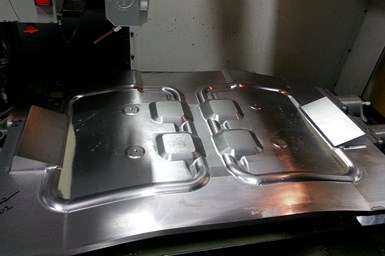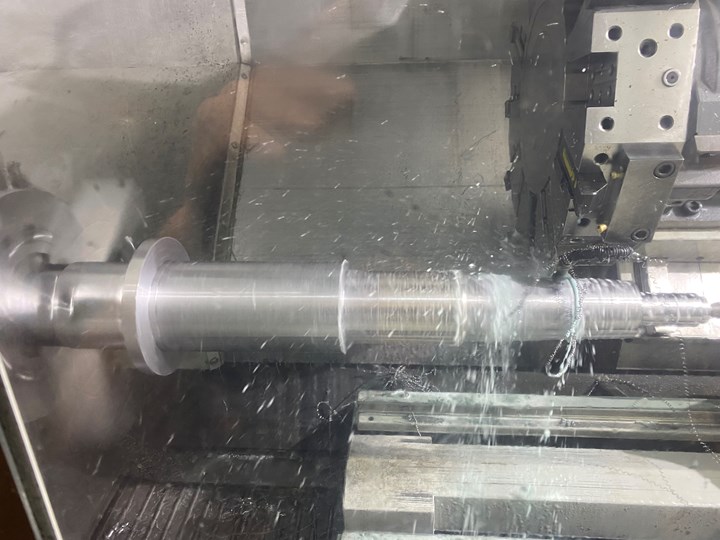4 Tips for Staying Profitable in the Face of Change
After more than 40 years in business, this shop has learned how to adapt to stay profitable.
Share





The difference between a machine shop owner and a hobbyist is profit. Shops are intended to make money, and the simple fact is that the path to staying profitable is rarely clear and straight. Staying in business means navigating the fluctuating needs of customers in an industry that experiences constant changes in technology. Staying in business is not easy, so it can be surprising to learn how long some shops have kept the chips flying.
While the company began in the automotive industry, Proto Tool had to expand into other end markets to cope with the fluctuations of the industry. They now produce parts for multiple industries, including this mold component for a marine part. Source: Proto Tool Company
Bruce Pankow founded Proto Tool Company in Detroit in 1980, the same year his son and current Proto Tool President Brian Pankow was born. The company began its life making gauges and machining features into assemblies and fixtures for the automotive industry. However, over the past 44 years the company has had to adapt both to new technologies and new industries to keep up with the changing expectations of customers.
I spoke with the Pankows about the advice they would give to machine shops aiming to stay in business as long as Proto Tool, and this is the advice they had.
1) Don’t Stay Married to One Market
The first and most important piece of advice they have? Be prepared to change to meet the needs of an ever-changing industry. “When I started, CNCs were kind of new, kind of specialized,” Bruce says. “Now, they’re the standard.” Brian agrees. “The industry changes, and you need to be able to adapt to technology. You have to keep up with it or be left behind.”And this philosophy goes beyond technology.
Proto Tool keeps a fleet of Haas VMCs and this Haas STL 40 for producing high-mix, low-volume work. While the company began in the automotive world, it has gravitated toward high-mix, low-volume work in a number of industries. Source: Proto Tool Company
When automotive work changed in the ‘90s, Bruce expanded to more markets. “The automotive industry just isn’t what it used to be, and no amount of hoping will change that,” says the elder Pankow. “It’s hard to stay competitive producing a handful of parts for a single industry. Hard for us, at least.” Currently, Proto Tool is ISO 9001-2015 certified and produces high-mix, low-volume work in multiple industries in addition to automotive, including municipal systems, agricultural and aerospace.
The change insulates it from shifts in market demand. “Sometimes, one half of the shop is busy, while the other is dead,” Brian says. “Other times, it’s reversed. The different industries are always in flux, and we have to be ready for any of them at any time.”
To meet the needs of these varied industries, the shop had to pivot toward flexibility, with a small fleet of varied machines capable of producing a wide range of parts. The shop has three Haas VMCs — one VF-6, and two VF-5s — all capable of four- and five-axis positional work. For turning, it has a Haas STL 50, two Mori Seiki SL-250s, and a Webster & Bennet vertical lathe with an 80-inch diameter work envelope for large workpieces. Additionally, the shop has two large CNC boring mills, also for larger workpieces. Finally, it has a handful of manual mills and lathes for quick turnarounds and extra capacity.
2) Find the Value You Bring to the Table
Most shops cannot take on every job that comes their way. The fact is that every shop needs to identify the ideal class of parts it can produce cost-effectively. Proto Tool, for example, is great at machining complex features into larger workpieces.
This vertical lathe has an 72-inch work table with an 80-inch swing, which enables Proto Tool to tackle large parts. Finding areas of competitive advantage like machining complex features into large parts has been key to the company’s success.
Source: Proto Tool Company
The company’s bread and butter is machining features into large weldments, up to 200 inches along the X axis and 90 inches along the Y, according to Brian. This enables the company to take jobs with part sizes that other shops might not be able to handle. Machining these larger parts has enabled the shop to remain profitable even as high-volume work fell by the wayside — so much so that the shop is preparing to install another large multi-axis CNC boring mill.
Finding a niche also meant being picky about what work it takes on. “We want to dictate what work we take in rather than having work dictated to us,” Bruce says. “We can’t make profits on pins.” Instead, the company focuses on jobs that require machining complex features — this includes turning large parts with multiple features, the weldments discussed above, and producing shafts with complex features. “We always look for parts with more unique features because that increases the benefits we bring to the customer,” Brian says. “That’s where we find success.”
3) Bringing Your Experience to New Markets
Another important tip: recognize when your experience applies to other areas. “There are a lot of similarities between different parts,” Brian says. “A bushing is a bushing whether it’s going into a car or a large fluid pump.” Similarly, the shop’s years spent turning shafts for automotive parts translated easily into turning shafts for municipal pumps.
After the shop moved into machining features onto large automotive weldments, the capacity for turning and machining large parts opened the doors for other large parts. Currently, the shop is turning large ring-shaped components with a 73-inch diameter on a CNC vertical lathe. The components require both ID and OD turning, as well as boring operations.
Thankfully, the shop has already built the skills needed for machining these features into large parts. “You run into different jobs over the years and learn from making them,” Bruce says. “You carry these lessons forward, and hopefully you’ll find a profitable path.”
4) You Can’t Ignore Luck
The shop, currently located outside Detroit in Farmington Hills, Michigan, has stayed in business for over 40 years, but not every shop has. “I know plenty of guys who ran very good businesses, made parts on time, but aren’t around anymore,” Bruce says.
However, those lucky enough to stick around can be useful. “The old man comes in handy,” Brian says. “He knows the entire industry, so if you need something done, he knows the guy to talk to.”
Hopefully, with some flexibility, ingenuity and a little luck, your shop can stick around, too.
Related Content
4 Commonly Misapplied CNC Features
Misapplication of these important CNC features will result in wasted time, wasted or duplicated effort and/or wasted material.
Read MoreRethink Quality Control to Increase Productivity, Decrease Scrap
Verifying parts is essential to documenting quality, and there are a few best practices that can make the quality control process more efficient.
Read MoreSelecting a Thread Mill That Matches Your Needs
Threading tools with the flexibility to thread a broad variety of holes provide the agility many shops need to stay competitive. They may be the only solution for many difficult materials.
Read More6 Variations That Kill Productivity
The act of qualifying CNC programs is largely related to eliminating variations, which can be a daunting task when you consider how many things can change from one time a job is run to the next.
Read MoreRead Next
Registration Now Open for the Precision Machining Technology Show (PMTS) 2025
The precision machining industry’s premier event returns to Cleveland, OH, April 1-3.
Read More5 Rules of Thumb for Buying CNC Machine Tools
Use these tips to carefully plan your machine tool purchases and to avoid regretting your decision later.
Read MoreBuilding Out a Foundation for Student Machinists
Autodesk and Haas have teamed up to produce an introductory course for students that covers the basics of CAD, CAM and CNC while providing them with a portfolio part.
Read More

































